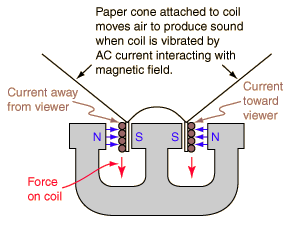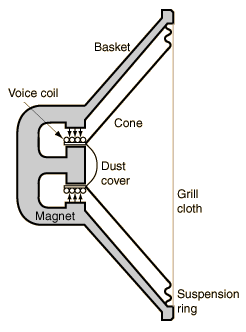
 |
Home : Speakers Introduction Loudspeaker Concepts: To hear the full richness of sound from our electronic devices , we have to move air so our ears respond to the frequencies in the range we can interpret, roughly 20-20,000Hz. To move the air is the job of the loudspeaker. For low frequencies, we use a large speaker cone called a woofer and for high frequencies we use a smaller one called a tweeter. This is because the cone which works best for low frequencies does not work best for high frequencies and vice versa. Mid-range single speakers are good for voice range frequencies but not so good for booming bass or high pitched sounds. Loudspeakers are analog devices and use an electro-mechanical process to try to reproduce sound. If there is an area in your audio/video setup where you need to splurge, this is it, because speakers are almost always the limiting element in a sound system. Dynamic Loudspeaker Principles  A current-carrying wire in a magnetic field experiences a magnetic force perpendicular to the wire. Loudspeaker Basics The loudspeakers are almost always the limiting element on the fidelity of a reproduced sound in either home or theater. The other stages in sound reproduction are mostly electronic, and the electronic components are highly developed. The loudspeaker involves electromechanical processes where the amplified audio signal must move a cone or other mechanical device to produce sound like the original sound wave. This process involves many difficulties, and usually is the most imperfect of the steps in sound reproduction. Choose your speakers carefully. Some basic ideas about speaker enclosures may help with perspective. The enclosure is an essential part of sound production because of the following problems with a direct radiating loudspeaker:  The sound from the back of the speaker cone will tend to cancel the sound from the front, especially for low frequencies. The free cone speaker is very inefficient at producing sound wavelengths longer than the diameter of the speaker. Speakers have a free-cone resonant frequency which distorts the sound by responding too strongly to frequencies near resonance. More power is needed in the bass range, making multiple drivers with a crossover a practical necessity for good sound. 
Loudspeaker Details A light voice coil is mounted so that it can move freely inside the magnetic field of a strong permanent magnet. The speaker cone is attached to the voice coil and attached with a flexible mounting to the outer ring of the speaker support. Because there is a definite "home" or equilibrium position for the speaker cone and there is elasticity of the mounting structure, there is inevitably a free cone resonant frequency like that of a mass on a spring. The frequency can be determined by adjusting the mass and stiffness of the cone and voice coil, and it can be damped and broadened by the nature of the construction, but that natural mechanical frequency of vibration is always there and enhances the frequencies in the frequency range near resonance. Part of the role of a good enclosure is to minimize the impact of this resonant frequency. Types of Enclosures The production of a good high-fidelity loudspeaker requires that the speakers be enclosed because of a number of basic properties of loudspeakers. Just putting a single dynamic loudspeaker in a closed box will improve its sound quality dramatically. Modern loudspeaker enclosures typically involve multiple loudspeakers with a crossover network to provide a more nearly uniform frequency response across the audio frequency range. Other techniques such as those used in bass reflex enclosures may be used to extend the useful bass range of the loudspeakers.  Use of Multiple Drivers in Loudspeakers Even with a good enclosure, a single loudspeaker cannot be expected to deliver optimally balanced sound over the full audible sound spectrum. For the production of high frequencies, the driving element should be small and light to be able to respond rapidly to the applied signal. Such high frequency speakers are called "tweeters". On the other hand, a bass speaker should be large to efficiently impedance match to the air. Such speakers, called "woofers", must also be supplied with more power since the signal must drive a larger mass. Another factor is that the ear's response curves discriminate against bass, so that more acoustic power must be supplied in the bass range. It is usually desirable to have a third, mid-range, speaker to achieve a smooth frequency response. The appropriate frequency signals are routed to the speakers by a crossover network.  NEXT - Crossover Networks |
|
Loudspeakers: |